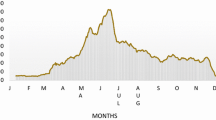Abstract
Recent studies describe interactions of pollen surfaces with aerosol particles; pollen surfaces undergo morphological changes and the release of allergens and allergenic fragments from the pollen can be enhanced. Thus allergens from pollen can be found in particle size fractions much smaller than undamaged pollen (<5Μm). This may explain allergic reactions in parts of the lungs which cannot be reached by undamaged pollen. In Switzerland the birch tree (betula verrucosa) major allergen Bet v 1 and the grass (phleum pratense) pollen major allergen Phl p 5 are of particular relevance for inducing pollinosis. In this study aerosols of different aerodynamic diameters were sampled by Andersen-Impactors over 18 months. Sampling areas are subjected to different levels of air pollution (Zürich, Switzerland, urban; Payerne, Switzerland, rural: Davos, Switzerland, alpine). Samples were scanned by electron microscopy and submitted to specific allergen assays (ELISA) for birch pollen major allergen Bet v 1 and grass pollen major allergen Phl p 5 respectively. Particle and major allergen concentrations were highest in Zürich, followed by Payerne and, significantly lower, Davos. Scanning electron microscopy investigations showed interactions of aerosols with pollen surfaces in Zürich and Payerne. The presence of Bet v 1 in smaller aerosol fractions was demonstrated in Zürich and Payerne some weeks before and after birch pollen was counted.
Similar content being viewed by others
References
Becker, W.M., Darsow, U. and Behrendt, H. (1990) Effect of extracts of airborne particulated matter on grass pollen Dactylis glomerata: allergen release and morphology. Allergologie 13, 443.
BUWAL. (1995) (Bundesamt für Umwelt, Wald und Landschaft): Luftbelastung 1994 (NABEL). Schriftenreihe Umwelt Nr. 244; Bern.
Chapman, M.D. (1988) Allergen specific monoclonal antibodies: new tools for the management of allergic disease. Allergy 43 (Suppl. 5), 7–14.
D'Amato, G., Spieksma, F. Th. and Bonini, S. (1991) Allergenic pollen and pollinosis in Europe. Blackwell, Oxford, UK, 37 pp.
Fahlbusch, B., Müller, W.D., Schlenvoigt, G., Jäger, L., Wahl, R. and Weber, B. (1993) Monoclonal antibody immunoassay for qualitative analysis of group V allergens in grass pollen extracts. Clin. Exp. All. 23, 747–754.
Fountain, D., Berggren, B., Nilsson, S. and Einarsson, R. (1992) Expression of birch pollen specific IgE-binding activity in seeds and other plant parts of birch trees. Int. Arch. Immunol. 98, 370–376.
Leuschner, R.M. and Boehm, G. (1979) Investigations with the ‘Individual Pollen Collector’ and the ‘Burkard Trap’ with reference to hay fever patients. Clin. Allergy 9, 175–184.
Monn, Ch., Schaeppi, G., Brändli, O., Leuenberger, Ph. and SAPALDIA team. (1994) PM10 concentrations and aerosol particle size distribution in outdoor air in eight regions of Switzerland. J. Aerosol. Sci. 25 (Suppl. 1), 159–160.
Pehkonen, E. and Rantio-Lehtimäki, A. (1994) Variations in airborne pollen antigenic particles caused by meteorologic factors. Allergy 49, 472–477.
Ruffin, J., Liu, M.Y.G., Sessoms, R., Banerjee, S. and Banerjee, U.C. (1986) Effects of certain atmospheric pollutants (SO2, NO2 and CO) on the soluble amino acids, molecular weight and antigenicity of some airborne pollen grains. Cytobios 46, 119–129.
Spieksma, F. Th., Kramps, J.A., Van der Linden, A.C., Nikkels, B.H., Plomp, A., Koerten, H.K. and Dijkman, J.H. (1990) Evidence of grass pollen allergenic activity in the smaller micronic atmospheric fraction. Clin. Exp. Allergy 20, 273–280.
Suphioglu, C. Singh, M.B., Taylor, P., Bellomo, R., Holmes, P., Puy, R. and Knox, R.B. (1992) Mechanism of grass-pollen-induced asthma. Lancet 339, 569–572.
Wüthrich, B. (1989) Epidemiology of the allergic diseases: Are they really on the increase? Int. Arch. Allergy Appl. Immunol. 94, 3–10.
Wüthrich, B., Schindler, C. Leuenberger, Ph., Ackermann-Liebrich, U. and the SAPALDIA-Team. (1995) Prevalence of atopy and pollinosis in the adult population of Switzerland (SAPALDIA-Study). Int. Arch. Allergy Immunol. 106, 149–156.
Author information
Authors and Affiliations
Rights and permissions
About this article
Cite this article
Schäppi, G.F., Monn, C., Wüthrich, B. et al. Analysis of allergens in ambient aerosols: Comparison of areas subjected to different levels of air pollution. Aerobiologia 12, 185–190 (1996). https://doi.org/10.1007/BF02248148
Received:
Accepted:
Issue Date:
DOI: https://doi.org/10.1007/BF02248148




